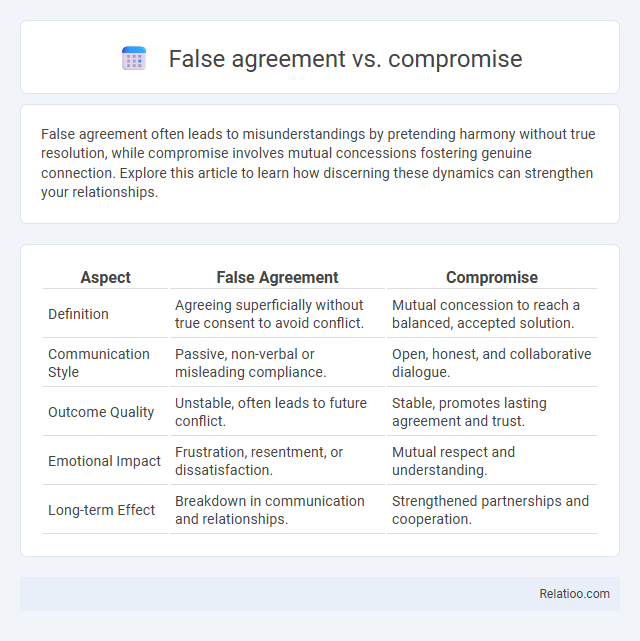False agreement often leads to misunderstandings by pretending harmony without true resolution, while compromise involves mutual concessions fostering genuine connection. Explore this article to learn how discerning these dynamics can strengthen your relationships.
Table of Comparison
| Aspect | False Agreement | Compromise |
|---|---|---|
| Definition | Agreeing superficially without true consent to avoid conflict. | Mutual concession to reach a balanced, accepted solution. |
| Communication Style | Passive, non-verbal or misleading compliance. | Open, honest, and collaborative dialogue. |
| Outcome Quality | Unstable, often leads to future conflict. | Stable, promotes lasting agreement and trust. |
| Emotional Impact | Frustration, resentment, or dissatisfaction. | Mutual respect and understanding. |
| Long-term Effect | Breakdown in communication and relationships. | Strengthened partnerships and cooperation. |
Understanding False Agreement and Compromise
False agreement occurs when parties mistakenly believe they have reached a consensus, leading to misunderstandings and unmet expectations, while compromise involves each party making mutual concessions to achieve a balanced and effective resolution. Understanding false agreement requires recognizing the signs of superficial consensus without genuine agreement on terms, whereas compromise emphasizes collaboration and problem-solving to meet core interests. Effective negotiation strategies prioritize clear communication and verification to avoid false agreements and encourage true compromise.
Key Differences Between False Agreement and Compromise
False agreement occurs when one party superficially consents to terms without genuine acceptance, often due to pressure or misunderstanding, leading to unresolved conflicts. Compromise involves mutual concessions where both parties actively negotiate to reach a balanced and satisfactory resolution. Key differences include the authenticity of consent and the intention behind agreement, with false agreements lacking true consensus and compromises reflecting deliberate collaboration.
Psychological Motivations Behind False Agreement
False agreement often arises from psychological motivations such as the desire for social acceptance, conformity, or avoidance of conflict, driving individuals to align opinions falsely with perceived group consensus. Your brain may prioritize social harmony over accuracy, leading to misreported agreement even when true beliefs differ. Understanding these motivations helps differentiate false agreement from genuine compromise, where parties willingly adjust views for mutual benefit rather than mere social compliance.
The Role of Communication in Reaching Compromise
Effective communication plays a crucial role in distinguishing false agreement from genuine compromise by fostering clarity and mutual understanding between parties. You can identify false agreement when parties superficially agree without truly reconciling differing views, often due to poor communication or avoidance of conflict. In contrast, productive dialogue enables both sides to express concerns, negotiate terms, and reach a compromise that genuinely satisfies shared interests.
Consequences of False Agreement in Relationships
False agreement in relationships often leads to unresolved conflicts and emotional disconnect, as one partner pretends to agree while harboring disagreement or resentment. Compromise, in contrast, involves mutual concessions that foster understanding and strengthen trust, promoting healthier communication. The consequences of false agreement include increased tension, reduced authenticity, and potential long-term damage to the relationship's foundation.
Benefits of Genuine Compromise
Genuine compromise fosters mutual respect and sustainable solutions by balancing the interests of all parties involved, unlike false agreement which may mask true disagreements and lead to unresolved conflicts. You benefit from genuine compromise through enhanced trust and collaboration, promoting long-term relationships and effective problem-solving. Prioritizing authentic dialogue and understanding ensures outcomes that are acceptable and rewarding for everyone.
Warning Signs of False Agreement
Warning signs of false agreement include vague or non-committal language, frequent pauses, and lack of enthusiasm during discussions. Participants may nod or verbally agree without fully understanding or consenting to the terms, leading to misunderstandings later. Identifying inconsistencies between verbal affirmations and body language helps distinguish false agreement from genuine compromise.
Strategies for Promoting Healthy Compromise
Promoting healthy compromise requires clear communication, active listening, and mutual respect to avoid false agreement, where one party pretends to agree without genuine consent. Your goal is to create an environment where all parties feel heard and understood, enabling real compromise rather than surface-level consensus. Strategies include setting transparent goals, encouraging open dialogue, and verifying understanding to distinguish true compromise from false agreement.
False Agreement vs Compromise in Workplace Dynamics
False agreement occurs when employees superficially consent to decisions or policies to avoid conflict, leading to unresolved issues and reduced trust. Compromise involves genuine negotiation where parties adjust their positions to reach a mutually acceptable solution, fostering collaboration and long-term workplace harmony. Understanding the distinction between false agreement and true compromise is essential for effective communication and sustainable conflict resolution in organizational environments.
Building Trust Through Authentic Compromise
False agreement undermines trust by creating a facade of consensus without genuine understanding or alignment among parties. Authentic compromise involves mutual respect and transparent communication, fostering lasting trust and collaborative solutions. Building trust through authentic compromise requires acknowledgement of differing perspectives and a commitment to equitable resolution rather than superficial agreement.

Infographic: False agreement vs Compromise
 relatioo.com
relatioo.com